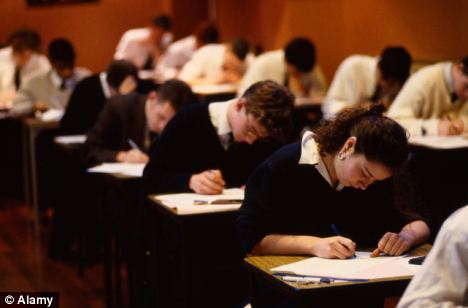The way out is through accountability.
Don’t Believe the State’s Higher Education Hype

The federal government is poorly positioned to solve our national problems.
The roiling controversy about the “value” of college has me thinking again about Nudge, the 2008 book by economist Richard Thaler and legal scholar Cass Sunstein. Nudge may be the Bible of bureaucratic bossiness. It makes the case that the world could be a whole lot better if only the right people in government and business were empowered to set up clever, often invisible incentives and manipulations to “help” the rest of us make better choices. The book’s subtitle, “Improving Decisions About Health, Wealth, and Happiness,” speaks volumes. The phrase lacks a subject—who exactly will be doing the “improving,” and how do we know that we can trust them?—but we’re promised wonderful things if we just follow The Program.
Nudge has a short subsection called “Nudging High Schoolers Toward College.” It spotlights a small initiative that used a handful of subtle tactics to increase the college-going rate in a community with lower-than-desired postsecondary attainment. This program did increase the percentage of students attending a state college, and so the approach began spreading to other high schools and finding its way into policy. The book betrays no apprehension that growing college attendance rates represent anything other than a public good.
Indeed, devotees of “nudging” appear blessed with a lack of self-doubt. They give the impression of moving effortlessly from the inkling of an idea, to certainty that it’s right, to implementation of the idea at scale so everyone can benefit. There seems to be precious little hand-wringing about whether their goal is actually the right one, precious little fretting about the wisdom and motives of those conjuring up the goal and the nudges, and precious little wondering about the possibility of unintended consequences. These would be capitulations to the backward beliefs of the past and the deficient decision-making of the unenlightened.
In hindsight, the college-going issue was especially susceptible to nudge-think. Data showed that a college degree was correlated with a whole host of good things, such as employment and higher earnings. There was also evidence that kids from disadvantaged families were less likely to earn college degrees. We were told that the kinds of post-war jobs that enabled the average American worker to have a family-sustaining income with only a high school diploma were disappearing, and that the jobs of the future would require postsecondary education. So getting everyone into college was the right thing to do.
The Cost of Good Intentions
“College for all” became a kind of rallying cry among education reformers, and strategies designed to accomplish that goal proliferated. Because we didn’t want cost to be an inhibition, the availability of taxpayer-supported student loans exploded. Meanwhile, as students needed a high school diploma to move on to higher education, enormous energy was poured into lifting high school graduation rates. More and more programs were created to help students pay for the SAT, submit college applications, and successfully transition from high school to college. Some elementary and middle schools even started identifying students by the year they would graduate from college.
It must be underscored that these activities were pursued by very well-meaning people. And in many cases, such undertakings helped improve the educational and employment prospects of students who, just a decade earlier, would’ve been counseled off the college path. But the good intentions came freighted with costs. In time, we’d see colleges—buoyed by students’ access to financial aid—dramatically increase their tuition costs and their layers of administration. Students started graduating college with staggering levels of debt and/or degrees that didn’t match employers’ needs. High school students who had been unprepared for or uninterested in higher education attended college anyway, in some cases dropping out and ending up underemployed, saddled with loans they couldn’t pay off. And when high school graduation rates turned out to be scandalously misleading, the value of diplomas became questionable. In sum, “college for all” inadvertently resulted in too little interest and investment in work-related, non-college postsecondary paths. There began to emerge an increasingly distinct—even if unintentional—implication that young people had failed unless they went to college.
In a sense, then, we inflated the demand for college. Our nudging ultimately served not just to alter behavior but to distort it. We can recognize this by looking at high schools and students. But we can also see it in the “Varsity Blues” scandal, wherein parents of means bribed their kids’ way into tight incoming classes. We can see it in the federal lawsuit against Harvard as families try to shine light on elite schools’ purposely opaque admissions processes. We can see it in recent survey data showing that—almost certainly in response to the staggeringly out-of-touch behavior on some campuses—only half of American adults, and only a third of Republicans, believe colleges are having a positive influence on the country.
Seeing College Like a State
Obviously a presumptuous, pro-technocracy book from a decade ago isn’t responsible for all of this. But there is a foundational problem of perception—a problem political scientist James Scott calls “seeing like a state”—that undergirds Nudge as well as the government’s role in our over-valuation of college.
When the state gears up to involve itself in a complex matter, we should first pause to ask about the biases of those charged with defining the problem. For instance, those who grew up on remote, rural ranches will generally see property taxes, guns, and environmental rules differently than those who grew up in rented urban apartments. Devoted churchgoers and atheists are likely to have different views about whether “of” or “from” has a more important place between the words “freedom” and “religion.” Wolves and sheep don’t see eye-to-eye on what makes for a good fence.
Along these lines, we need to be cognizant that nearly all policymakers graduated from college. Philanthropists generally went to college; so did newspaper editorial-board members and other policy influencers. But only about a third of adult Americans have a college degree. It is understandable, then, that those driving education policy are going to have a disproportionately pro-college point of view—or, as one smart observer once put it, school conversations can be dominated by those who were good at school.
Add to this the fact that, because the government has limited capacity to know and appreciate all of the causes and effects of complex systems, it has a tendency to radically oversimplify how it assesses the fields in which it is active. That is, a faraway state enterprise can’t know everything—and certainly can’t measure everything—about shifts in the economy, the consequences of welfare programs, the influence of parks, or the benefits of elementary schools.
So government agents choose a very small number of measurable indicators that seem to capture the essence of the field—hence the government’s narrow focus on gross domestic product, the percentage of social-service participants who are employed, the number of visitors to a park, and the reading and math scores of fourth graders. It’s not that these measures are unimportant or unreliable. In fact, they are important, and they are reliable. But they are highly limited. They don’t reflect the full scope of a system’s purposes or consequences. They do, however, reflect how the state sees the core feature of that system. As a result, state actors charged with holding a system “accountable” can end up warping that system by focusing on one indicator to the exclusion of many others.
There is no doubt that higher education is valuable; it can provide enormous benefits to individuals and society. But we have exaggerated the importance of graduating from a four-year institution at least in part because of the worldview of our decision-makers and the constrained ken of the government. Yes, the number of bachelor’s degrees earned is an indicator of the success of our education system. But it is not the indicator. Other things matter: knowledge of history, employability, appreciation of culture, mental and physical health, civic virtue, resilience, capacity to contribute to family and community, personal contentment, and so on.
It is useful to understand the current excesses in higher education—excesses in cost, student debt, campus behavior, and so much more—as downstream effects of our disproportionate focus on college. Putting the bachelor’s degree back in perspective, then, may be the foundational reform for broader efforts to improve higher education. This does not mean slashing funds for four-year institutions, vilifying academia, or limiting student access. But it does mean recognizing that efforts to nudge America toward higher and higher college-going rates have not come without costs.
The American Mind presents a range of perspectives. Views are writers’ own and do not necessarily represent those of The Claremont Institute.
The American Mind is a publication of the Claremont Institute, a non-profit 501(c)(3) organization, dedicated to restoring the principles of the American Founding to their rightful, preeminent authority in our national life. Interested in supporting our work? Gifts to the Claremont Institute are tax-deductible.
K-12 is the key to reforming education in America.
The University of Tulsa is a case study in the depredations of disruptive innovation in higher education.
Practical solutions for one of the country's biggest problems.




